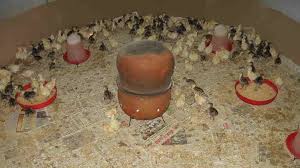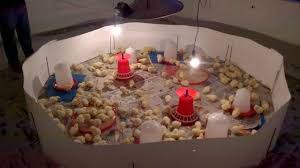Brooder guards are very useful during the first few weeks of chicks in the brooder house because they help to confine the chicks to the source of heat, food and water.
With this in place, every chick in the house can have access to the food and water without strain and chicks would not over-crowd themselves.
If you ask any poultry farmer. He will tell you one of the most critical stages in poultry farming is those few weeks during brooding. From day-old e.g. 1-14 days, because that is the defining moment. Where you either get it right or wrong.
A brooder guard is used during the first week or two of brooding. It keeps the chicks near the heat source and out of drafts and used as fence for starting chicks.
The use of brooder guards has been indicated as safe and convenient. It comes in a roll that can spread out into a circle or crimped or folded to make corners. This gives you lots of options for placing and fitting the brooder guard into your brooding area.
However, brooder guards can be removed when most of the chicks can fly over them during the hot season, removal can be after 2 weeks and at this stage, most of the chicks are already feathered to fly over the guards.
The height of the guard is normally 18-24 inches and it can be made of cardboard round the chicks.
Key points to take note during brooding:

- Check the quality of the crumbs, not too hard, not too big it should be palatable to the chicks.
- Avoid the build-up of fine particles in the feeders from the first weeks. Making sure they are emptied at least once each week.
- An even distribution of the feeders over the brooding area will make it easier for the chicks to locate the feeds.
Read Also: Internal Poultry Diseases and Post Mortem Examination
The objectives of brooding are:
- Provide a good conducive environment for rapid growth and metabolic activities.
- Get a good start and a low mortality level during the first 2 weeks of life.
- To reach the target body weight at 5 weeks of age.
- Good weight and growth uniformity among birds from the beginning.
- To have a well-built body frame, development of vital organs as well as a well developed immune system.
- Excellent livability.
Brooder Guard
- Brooder guard is used within the first or two weeks of brooding. It keeps the chicks near the heat source and to prevent draft air from reaching the chicks.
- Make the guards from material, which can be properly cleaned and sterilized.
- The height of the brooder guards should be approximately 16 inches to 18 inches.
- Guards will ensure chicks stay near the source of heat.
- It helps in preventing chilling and piling.
- Th brooder guards should be circular, to avoid stampede and crowding at the corner.
Brooder Management

- Start and adjust the brooder stoves 24 hours before the arrival of chicks.
Ensure that they are working correctly. - Spreadsheets of paper over the cage bottom to last for 7 days. It improves floor temperature by reducing insulation.
- Drinkers and feeding trays should be properly washed before arrival if possible sun-dried.
- Disinfectant used in washing the feeding equipment should be properly dry and remain odorless before the arrival of the chicks.
- Make sure that the nipples and round drinkers are on the correct height, nipples at eye level of the chicks.
- Round drinkers should be on the floor in such a way and manner that the chicks will not get wet, cold and drown.
- Spread paper on the floor to attract the chicks and put also extra feed over the chick paper or paper trays to encourage eating.
- Upon arrival wait 3 to 4 hours before distributing food to make sure chicks first drink enough water to restore their body fluid.
- During the first 2 days use tepid, slightly warm water from 25º to 30 ºC.
- The removal of the supplementary starter drinkers should be done gradually, making sure that the chicks have acquired the habit of using the other drinkers.
- It is useful to monitor water consumption. To maintain litter quality, avoid water spillage during brooding.
- The drinkers should be cleaned daily for the first 2 weeks. From the third week, they should be cleaned each week.

Day old chicks
Read Also: How to Handle the Arrival of Day Old Chicks (D.O.C)
Temperature and Humidity Suitable for Brooding
According to research, the first few days are very crucial and critical. It is advised that the farmer makes himself available at all times.
So that he can periodically check on the chicks from time to time to ensure their comfortability and well being.
He has to be very observant and sensitive. To avoid any serious mistakes that will jeopardize his effort. This is where his real passion and skills come to play.
To ensure that the equipment and the litter are warm for chick arrival. We advise starting to raise the house temperature at least 36 hours before chick arrival so that it reaches a house temperature of 28 to 31°C.
The concrete floor must be at 28°C and litter at 30°C. The best way to check if the house temperature is correct during the first days after arrival. It is to measure the cloacal temperature of the chicks (40°C/104°F) and be very observant.
Observing the chicks will tell you whether or not the temperature is correct. If they are too cold, they will huddle near the heat source. If they are too warm, they will spread out away from the heat source. If there are drafts of air, they will huddle in groups to get away from the spot where the cool air enters the heated area.
Comfortable chicks will spread out uniformly during brooding, without huddling. Throughout the brooding area. Look for signs of overheating (panting and drowsiness) or chilling (huddling and loud chirping).
And make appropriate adjustments. Heat control is more critical in cage brooding because the chicks cannot move to find their comfort zone.

day-old chicks
Lighting Program
During brooding i.e. the first few days, it is important to maintain the chicks under a maximum light regime 22 to 23 hours. To encourage the intake of water and feed.
Feeding Regime During Brooding
During this period from day old to 5 weeks old. The bird is not able to adapt its feed consumption to the energy level.
To encourage good growth, we recommend using a diet presented in crumb form. With an adequate concentration of protein and energy from 0 to 28 days in temperate climates. And from 0 to 35 days in hot climates (in both conditions till the body-weight target is reached).
Read Also: The Products Derived From Commercial Wastes
Frequently Asked Questions
We will update this section soon.

